The Windshield Wiper
Forehand
By Jeff Counts
In my first two articles on the professional forehand, (Click Here), I discussed why I think the "double bend" structure leads to such blistering pace on professional forehands. Now let's see the role of this underlying structure in the windshield wiper action that is common in pro tennis. In my opinion this wiper action is widely misunderstood and often executely
In the earlier articles, I thought it was important to address the issue of the double bend, because emphasizng this structure may appear restricive to players learning the game. The natural tendency for anyone learning tennis is to swing the arm around the body in an unstructured way, with the tip of the racket picking up speed, much like a baseball swing or a golf swing. This type of swing feels fast and whippy, is easy to execute, and would seem to be the best way to hit the ball hard, because of the speed it generates in the racket head. But as happens in golf or baseball, the tip of the racket quickly arcs around the body toward the opposite side.
This might be great for pure speed. But does racket speed equal ball speed and spin? The physics of a springy ball meeting tension-wound strings is very different than a hard baseball bat meeting a rocket solid baseball. For this reason, tennis strokes have to be controlled.
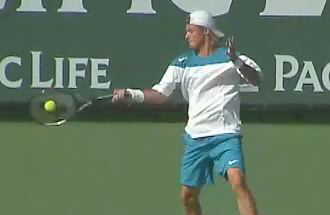 |
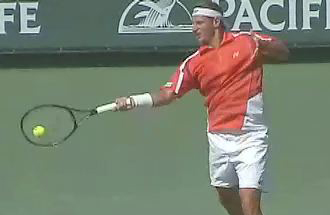 |
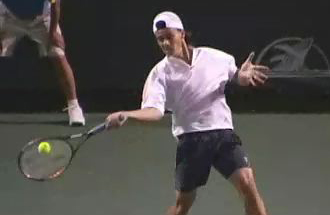 |
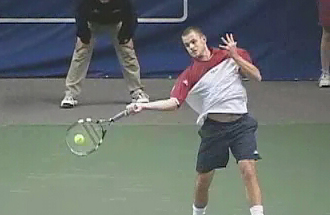 |
The double bend hitting arm position, with the elbow tucked in toward the waist, the wrist laid back, and the tip of the racket tilted down toward the court. |
|
In tennis, a racket meeting a ball is a supercharged spring event, where the squishy compressible ball squashes into, and pushes back, the tension-wound strings before springing back. We can actually see this incredible compression/spring occur in very high speed footage of professional strokes. To maximize this spring, you must have a solid structure on contact, and you must move forward with the ball to enhance the spring off the racket. When lower level players hit the ball with their big swings coming around the body, there is typically no arm and shoulder support behind the strings on contact to aid in this energy exchange. And the arc is almost completely circular, allowing no forward push through contact.
When the pros make contact with the ball, you see a wonderful double bend, where the shoulder and hand are solidly behind the racket on contact. The ball compresses not only into the strings, but (indirectly at least) into the supporting hand and shoulder. There is another interesting aspect to the double bend on contact here. This is where we can see the relationship between the windshield wiper and the double bend. Look how the racket tip is pointed down toward the ground at about 45 degrees (most noticeably with Coria and Roddick). This racket angle will aid in the windshield wiper motion because it allows the players to lift up the back of the ball.
In the earlier articles, I suggested that the double bend let's you use your shoulder to thrust up and forward, enhancing the spring off the strings. While lower lever players swing across the ball quickly, the pros stay behind the ball for a long time (at least in the relatively brief world of a tennis stroke). They do this by pushing the double bend forward and up. In thesecond article I offered several video clips showing how the pros push and lift their upper arms through contact, causing the upper arm to end up parallel (or higher) to the ground. (Click Here.)
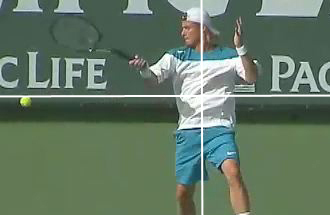 |
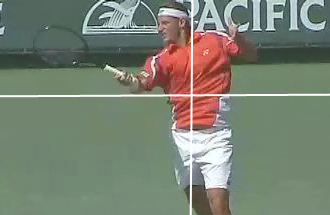 |
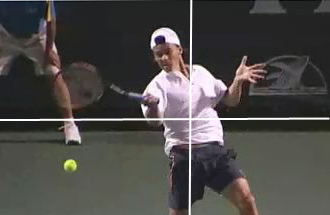 |
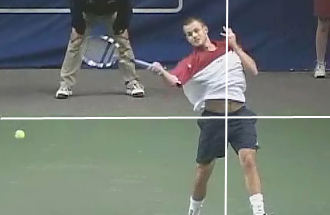 |
After contact the players retain the double bend hitting arm shape with the racket facing the net, even as they are executing the wiper motion. |
|
That same double bend structure, combined with a lift and thrust from the shoulder, powers the "windshield wiper" forehand we see so often in professional forehands. This windshield wiper motion is, in my opinion, not well understood. Typically people focus on the racket itself, and try to copy this forehand by "wiping" the racket over the ball. As in my first two articles, I want to pull back our lens from the racket itself so that we can see the supporting forces that actually drive the racket through the ball.
In the first group of still images above consider how remarkable it is that the racket continues to face the net, is still on the right side of the body, and is still perfectly supported by the hand and shoulder long after the ball has gone. If you could freeze time, and could press on these players rackets, you could see how well supported the racket is by the hand and shoulder, even after the ball has left the strings.
If you freeze the video of a lower level player at this point in the forehand, the tip of the racket would have come around the body. The strings would be facing the side fence, and the shoulder would not be behind the racket at all. The only way you can be in this pro position after contact is if your wrist and hand stayed back through contact and your shoulder pushed and lifted the hand forward.
It is very clear to me that the shoulder is the key muscle that supports the entire double bend, and it is the unique way the shoulder moves that gives us the push through contact and the windshield wiper finish. How does the shoulder wok? The shoulder is a ball-and-socket joint that allows the arm to rotate in a circular fashion or to hinge out and up, away from the body. So this is two types of movement. This hinging out and up motion of the shoulder explains how the shoulder can push the hand forward through contact. The circular rotating motion is what explains the windshield wiper finish.
From double bend to box finish, the indication that the player has used his shoulder to push up and out, but also rotate the hand, arm and racket. |
|
If you focus on the pros shoulder muscles, you can really see how the shoulder first pushes and lifts, and then turns the entire upper arm and hand over. Looking at the finish of these forehands, you will notice the exact same reference points. The chin is touching the shoulder because the shoulder has lifted and turned over (on contact, the shoulder was well below and to the right of the chin). The forearm is parallel to the ground and well in front of the body. The hips remain in the same position they were on contact - facing the net.
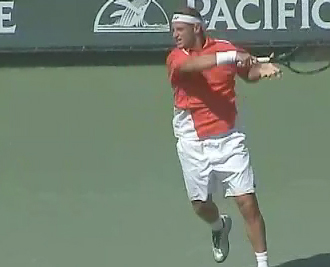 |
The Box Finish, formed by the upper arm forearm and shoulders. |
I refer to this finish as the "box" finish because the upper arm, forearm, and shoulders form a box. It looks like there is a perfect square between Nalbandian's shoulders and his forearm. If you look at the other finishes above, you will see the same "box" finish.
This Box Finish is a great indication that a player has driven through the ball properly and rotated over from the shoulder. If you see the forearm pressed tight into the body, or you see that the upper arm and forearm are not parallel to the ground, it is a pretty good indication that the windshield wiper motion has not been executed correctly.
To sum up the windshield wiper motion, the racket at first holds back as the body pushes, but then turns over. This is the sequence of the professional wiper. By using your powerful shoulder to drive through and then over, you will be able to hit a very '"heavy" forehand. This is the magic that the double bend brings. It keeps the shoulder behind the hand and racket all the way through, and even after, contact.
The final characteristic of the pro "windshield wiper" forehand is the final shape of the follow through. What you see is the strings of the racket move facing the net in the shape of a rainbow. With lesser skilled players, the tip of the racket comes across the body too soon and you don't see this full rainbow. This is the graphic I use on my website to show what the full shape of a proper windshield wiper forehand looks like. Notice how the strings of the racket face forward the entire time. And look at the rainbow arc (windshield wiper) that is created. If I took the frames from the above video clips, you would see the exact same full rainbow path.
 |
The rainbow arc of the windshield wiper finish, indicating the dual use of the shoulder in the modern pro forehand. |
Now compare the full shape of the rainbow arc that David Nalbandian and Mariano Zabaleta generate to the shape of the young player below. Look how the tip of the racket hinges across his body, like a door closing shut? Why is his racket path moving across his body, whereas the pros above get a full rainbow arc? Why does he finish with his arm and racket pressed tight against his chest, while the pros finish with the full "box" finish? The answer lies in how the shoulder is used (or not used) to drive the forehand.
In the sequence below, the shoulder has been taken out of the shot. Rather than hinging forward and up, driving the palm of the hand forward through the ball, his shoulder remains in the exact same position in the first frame as the last frame. His forehand is not being powered by his shoulder at all. Instead his racket is doing all the work, swinging straight across the ball. This is typically what happens when a player tries to generate "racket head speed". Instead of using the body to drive the ball, far too many young players put all the energy into the racket head. The result is that the racket jerks across the body.
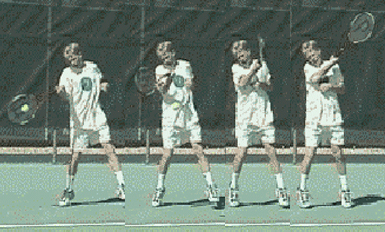 |
The "hinge across the body swing" with the shoulder staying in the same position. |
This type of "hinge across the body" swing is what I see almost all the time with lower level players (and many higher level players as well). If I see the tip of the racket come across the body like this, I know a player has technical problems. You can't fix the problem by simply "altering your swing path" or making small adjustments to the existing stroke. It actually involves learning to use your body differently. Specifically it involves learning how to use your shoulder as your primary power source to drive the ball forward and up. This will give you the true "windshield wiper" forehand, where the shoulder is hinging forward and then rotating over, giving you the fully shaped forehand that the pros use to rip the ball every time.




